Forts and Monuments Tour Package, Punjab
>> Click for Details & Price QuoteITINERARY:
Day 01 : Amritsar
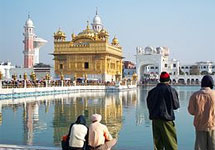 Arrive Amritsar Railway Station. On arrival meet and greet by our representative who will take you to the hotel. Check in hotel. Relax for a while. Overnight stay.
Arrive Amritsar Railway Station. On arrival meet and greet by our representative who will take you to the hotel. Check in hotel. Relax for a while. Overnight stay.
Day 02 : Fort Gobindgarh
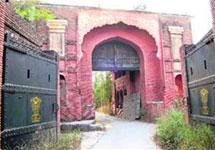 The fort occupied a unique place in the Indian military history. Built in 1760, it was called Bhangian Da Kila (Bhangis was one of the twelve Sikh misles). According to historians, during 1808, the fort was known as the fort of Gujjar Singh Bhangi. Later it was re-built by Maharaja Ranjit Singh with the help of Jodh Singh. The legendary Maharaja strengthened the fortification of the fort in order to keep his treasures and treaties in safety. The specially constructed Toshakhana, in the centre of the fort, also stored large amount of grains and provisions for the 12,000-strong army.
The fort occupied a unique place in the Indian military history. Built in 1760, it was called Bhangian Da Kila (Bhangis was one of the twelve Sikh misles). According to historians, during 1808, the fort was known as the fort of Gujjar Singh Bhangi. Later it was re-built by Maharaja Ranjit Singh with the help of Jodh Singh. The legendary Maharaja strengthened the fortification of the fort in order to keep his treasures and treaties in safety. The specially constructed Toshakhana, in the centre of the fort, also stored large amount of grains and provisions for the 12,000-strong army.
The fort was constructed with brick and lime with numerous army bastions and iron gates with 25 cannons on the ramparts, now replaced with modern weaponry.
The fort was constructed on a square pattern with a parameter of 1500 sqmt with two strong gates, four large bastions and well-defined rampart.
The majestic entrance has been named Nalwa Gate, after the great Sikh warrior. The other end of the gate is known as Keelar Gate and it is rumoured that in its close proximity existed an escape tunnel, connecting to Lahore tunnel. However, the army authorities said that they had not been able to locate any such tunnel so far.
The British Army had added Darbar Hall, HawaMehal and PhansiGhar (hanging place) to the fort after the annexation of Punjab. After Partition, the fort provided a temporary shelter to a large number of refugees from Pakistan. In October 1948, the fort was handed over to the Indian Army. Overnight stay hotel.
(To visit Gobindgarh fort need special permission)
Day 03 : Bathinda
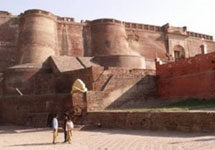 After Breakfast drive to Bhathinda to visit Qila Mubarak Fort,The fort at bhathinda is possibly the oldest in Punjab,going back as far as the early Christian era.Intended as a safeguard against invasion,theQila Mubarak resembles as Schooner shaped fort stands like a ship in a sea of sand; design eminently suited to the desert environment; is reputed to be 1800 years old. The Bathinda fort, which has stood since the period of Raja Deb (3rd century), one of the ancestors of Vinaipal is, an endangered structure now. The first woman ruler (1236 AD) of India, Razia Sultan, was imprisoned in this fort. It was the capital of the kingdom of Jaipal (1004). Mahmud Ghazni captured the town and laid it waste by his loot, arson and plunder. Patiala ruler Maharaja Karam Singh (1813-1834) renamed it Gobindgarh in memory of the visit of Guru Gobind Singh’s to the fort. Overnight Stay in Bhathinda at hotel.
After Breakfast drive to Bhathinda to visit Qila Mubarak Fort,The fort at bhathinda is possibly the oldest in Punjab,going back as far as the early Christian era.Intended as a safeguard against invasion,theQila Mubarak resembles as Schooner shaped fort stands like a ship in a sea of sand; design eminently suited to the desert environment; is reputed to be 1800 years old. The Bathinda fort, which has stood since the period of Raja Deb (3rd century), one of the ancestors of Vinaipal is, an endangered structure now. The first woman ruler (1236 AD) of India, Razia Sultan, was imprisoned in this fort. It was the capital of the kingdom of Jaipal (1004). Mahmud Ghazni captured the town and laid it waste by his loot, arson and plunder. Patiala ruler Maharaja Karam Singh (1813-1834) renamed it Gobindgarh in memory of the visit of Guru Gobind Singh’s to the fort. Overnight Stay in Bhathinda at hotel.
Day 04 : Kapurthala
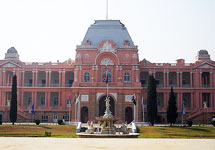 After breakfast drive to Kapurthala visit Jagatjit Palace is a remarkable building situated in Kapurthala in Punjab. It was the erstwhile palace of Maharaja Jagatjit Singh and was modelled after the Versailles Palace. Presently, the Jagatjit Palace is managed by the Defence Ministry and Kapurthala Sainik School functions in this building.Jagatjit Palace are a unique example of French architecture. The painted ceilings and the plaster of Paris figures represent the finest of French art and architecture. The interior decoration of the palace is exquisitely garnished with imported art work from France, Italy and Holland. The Darbar hall of the palace is one of the finest in India. After Lunch visit Moorish Mosque-A spectacular example of the secular history of Kapurthala is the Moorish Mosque, a famous replica of the Grand Mosque of Marakesh, Morocco, was built by a French architect, Monsieur M Manteaux. Its construction was commissioned by the last ruler of Kapurthala, Maharajah Jagatjit Singh and took 13 years to complete between 1917 and 1930. It was then consecrated in the presence of the late Nawab of Bhawalpur. The Mosque's inner dome contains decorations by the artists of the Mayo School of Art, Lahore. The Mosque is a National Monument under the Archeological Survey of India. It was one of the monumental creations in the State during the premiership of late Diwan Sir Abdul Hamid Kt., CIE, OBE. It was his keen interest with Maharaja's blessings that the mosque was completed. Its wooden model lay at the entrance of the Lahore Museum.Overnight stay at Stay at kapurthala.
After breakfast drive to Kapurthala visit Jagatjit Palace is a remarkable building situated in Kapurthala in Punjab. It was the erstwhile palace of Maharaja Jagatjit Singh and was modelled after the Versailles Palace. Presently, the Jagatjit Palace is managed by the Defence Ministry and Kapurthala Sainik School functions in this building.Jagatjit Palace are a unique example of French architecture. The painted ceilings and the plaster of Paris figures represent the finest of French art and architecture. The interior decoration of the palace is exquisitely garnished with imported art work from France, Italy and Holland. The Darbar hall of the palace is one of the finest in India. After Lunch visit Moorish Mosque-A spectacular example of the secular history of Kapurthala is the Moorish Mosque, a famous replica of the Grand Mosque of Marakesh, Morocco, was built by a French architect, Monsieur M Manteaux. Its construction was commissioned by the last ruler of Kapurthala, Maharajah Jagatjit Singh and took 13 years to complete between 1917 and 1930. It was then consecrated in the presence of the late Nawab of Bhawalpur. The Mosque's inner dome contains decorations by the artists of the Mayo School of Art, Lahore. The Mosque is a National Monument under the Archeological Survey of India. It was one of the monumental creations in the State during the premiership of late Diwan Sir Abdul Hamid Kt., CIE, OBE. It was his keen interest with Maharaja's blessings that the mosque was completed. Its wooden model lay at the entrance of the Lahore Museum.Overnight stay at Stay at kapurthala.
Day 05 : Jalandhar
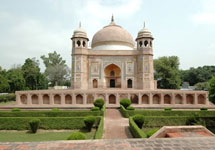 After breakfast at hotel, drive to nakodar visit Tomb of Haji Jamal is close to the tomb of MuhammedMomin. This tomb was raised over the mortal remains of Haji Jamal, a pupil of UstadMuhammedHusseini, the tambura player, towards the close of Emperor Shah Jahan’sregin. The two lined inscription engraved on the entrance gate of the tomb refers to its bing the tomb of Haji Jamal and gives a date of AH 1067 ( AD 1657). It stands in the middle of the square platform, panelled on all sides with deep recesses concealing two flight of steps on each side. Each of the four faces have octagonal recesses covered by pointed archs. The southern one gives access to the burial chamber while the remaining ones are closed with pierced tracery screens. Its inner chamber is octagonal where as the outer plan is square having octagonal turrets surmounted with domed cupolas added to the corners. A bulbous dome crowned with pinnacle sits over a high drum and is balanced by the four cupolas crowning the turrets at the cornor. The façade is divided into red stucco covered brick framed panels and painted with white lines. The larger panels are filled with flower pots and the smaller with geometrical designs. The broad belts between the panels are ornamented with diper designs in tiles of different colours. The octagonal towers and the battlements as well as the pinnacles of the domes are ornamented with glazed tiles. Overnight stay at jalandhar.
After breakfast at hotel, drive to nakodar visit Tomb of Haji Jamal is close to the tomb of MuhammedMomin. This tomb was raised over the mortal remains of Haji Jamal, a pupil of UstadMuhammedHusseini, the tambura player, towards the close of Emperor Shah Jahan’sregin. The two lined inscription engraved on the entrance gate of the tomb refers to its bing the tomb of Haji Jamal and gives a date of AH 1067 ( AD 1657). It stands in the middle of the square platform, panelled on all sides with deep recesses concealing two flight of steps on each side. Each of the four faces have octagonal recesses covered by pointed archs. The southern one gives access to the burial chamber while the remaining ones are closed with pierced tracery screens. Its inner chamber is octagonal where as the outer plan is square having octagonal turrets surmounted with domed cupolas added to the corners. A bulbous dome crowned with pinnacle sits over a high drum and is balanced by the four cupolas crowning the turrets at the cornor. The façade is divided into red stucco covered brick framed panels and painted with white lines. The larger panels are filled with flower pots and the smaller with geometrical designs. The broad belts between the panels are ornamented with diper designs in tiles of different colours. The octagonal towers and the battlements as well as the pinnacles of the domes are ornamented with glazed tiles. Overnight stay at jalandhar.
Day 06 : Ludhiana
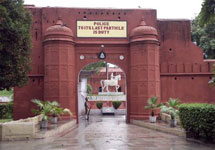 After breakfast visit Phillaur Fort Phillaur town, originally named ‘Phulnagar’ after SangheraJatPhul, was an important frontier site that commanded the most frequent Satluj Ferry. Maharaja Ranjit Singh, recognizing its caliber appointed a strong force under the leadership of Governor Mohkam Chand there. This army troop was stationed at Phillaur from the year 1808 to 1812. When Maharaja Ranjit Singh lost the Lodhi Fort of Ludhiana to British, he established a strong fort at Phillaur as a countermeasure. It is reported that this fort was designed by DewanMokham Chand and an Italian architect executed the project of this citadel. Shifting hands from Sikh Power to British Governance, this fort is now occupied by Punjab Police Academy. A police training centre is now in operation in Phillaur Fort and the Finger Print Bureau is also functional here.
After breakfast visit Phillaur Fort Phillaur town, originally named ‘Phulnagar’ after SangheraJatPhul, was an important frontier site that commanded the most frequent Satluj Ferry. Maharaja Ranjit Singh, recognizing its caliber appointed a strong force under the leadership of Governor Mohkam Chand there. This army troop was stationed at Phillaur from the year 1808 to 1812. When Maharaja Ranjit Singh lost the Lodhi Fort of Ludhiana to British, he established a strong fort at Phillaur as a countermeasure. It is reported that this fort was designed by DewanMokham Chand and an Italian architect executed the project of this citadel. Shifting hands from Sikh Power to British Governance, this fort is now occupied by Punjab Police Academy. A police training centre is now in operation in Phillaur Fort and the Finger Print Bureau is also functional here.
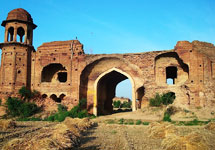 Later visit drive to Ludhiana to visit Lodhi Fort the lieutenants of Sikandar Lodi, the second ruler of the Afghan Lodi Dynasty who reined Ludhiana from 1481 AD constructed Lodhi Fort in the last decade of 15th century. Stationed at the strategic location on the banks of the river Satluj, this more than 500 years old military fort is now in a decrepit condition. Nihang Khan, one of the military generals sent by BadshahSikandar Lodi stayed in this fort and protected the entrance to the newly established Lodhi Ana. Maharaja Ranjit Singh was in possession of Ludhiana as well as Lodhi fort for some years that repulsed many British invasions with the help of the strong architecture of Lodhi Fort. However, Lodhi Fort fell into the hands of British with his decline. This massive structure spread over an extensive area of 5.6 acres was well maintained during the British Rule. After Independence, Sikh regiments of Indian Army were lodged in this fort for some decades. But after their withdrawal, the Lodhi Fort started crumbling due to the lack of maintenance. Moreover, Ludhiana citizens also started encroaching upon the fort premises and started digging it for making space to build their houses and shops. Even the Archaeological Department of India hasn’t helped in the conservation of this historical edifice and today some parts of the fort have completely vanished. Only some ruins of the ponderous outer wall, two colossal entrance gates opening to the meandering paths leading towards the interiors of the fort and some damaged barracks stand representing the grand history of Ludhiana at present Government Institute of Textile and Dyeing Technology was housed in this fort earlier, but it has been shifted to other location presently and the fort is left untended and unguarded.Overnight stay at hotel.
Later visit drive to Ludhiana to visit Lodhi Fort the lieutenants of Sikandar Lodi, the second ruler of the Afghan Lodi Dynasty who reined Ludhiana from 1481 AD constructed Lodhi Fort in the last decade of 15th century. Stationed at the strategic location on the banks of the river Satluj, this more than 500 years old military fort is now in a decrepit condition. Nihang Khan, one of the military generals sent by BadshahSikandar Lodi stayed in this fort and protected the entrance to the newly established Lodhi Ana. Maharaja Ranjit Singh was in possession of Ludhiana as well as Lodhi fort for some years that repulsed many British invasions with the help of the strong architecture of Lodhi Fort. However, Lodhi Fort fell into the hands of British with his decline. This massive structure spread over an extensive area of 5.6 acres was well maintained during the British Rule. After Independence, Sikh regiments of Indian Army were lodged in this fort for some decades. But after their withdrawal, the Lodhi Fort started crumbling due to the lack of maintenance. Moreover, Ludhiana citizens also started encroaching upon the fort premises and started digging it for making space to build their houses and shops. Even the Archaeological Department of India hasn’t helped in the conservation of this historical edifice and today some parts of the fort have completely vanished. Only some ruins of the ponderous outer wall, two colossal entrance gates opening to the meandering paths leading towards the interiors of the fort and some damaged barracks stand representing the grand history of Ludhiana at present Government Institute of Textile and Dyeing Technology was housed in this fort earlier, but it has been shifted to other location presently and the fort is left untended and unguarded.Overnight stay at hotel.
Day 07 : Patiala
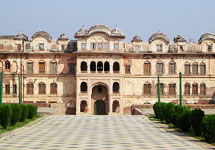 After breakfast drive to Patiala is the erstwhile princely state of Punjab, which is situated in malwaregion. Visit Bhadurgarh Fort 6 kms from Patiala, initially founded by NawabSaif Khan in 1658. The present fort was built by Maharaja Karam Singh of Patiala in 1837. It has two circular ramparts and is surrounded by a moat and covers an area of 2100 sq meters. This rather compact but nicely designed citadil is in the custody of the Department of police.The four wails of the fort enclose the village Saifabad located on the left-side of the Rajpura-Patiala Road. Saif Khan, a relative of the Mughal Emperor Aurangzeb, after holding several important offices, became a hermit and settled down here. After his death he was buried here. His tomb behind the fort, a structure of 177 x 177 ft. is in a state of neglect. Notwithstanding this, his followers still lit a lamp on the tomb every Thursday. Sheesh Mahal Patiala The Sheesh Mahal is the famous tourist place in Patiala. Maharaja Narinder Singh built this Mahal in 1847. The design and the decoration of the palace were chosen by Maharaja Narinder Singh to a large extent. One section of Sheesh Mahal is decorated with colored glass and mirror work and it is also known as ‘Palace of Mirrors’. It is situated behind the MotiBagh Palace. It is a triple storey building. There is a bridge across the artificial lake in the centre of the palace. This bridge is known as LakshmanJhoola. There are gardens and fountains on the sides of the lake. Sheesh Mahal was the presidential palace of Maharajas of Patiala. To give the artistic look on the walls and ceilings of the Sheesh Mahal, Maharaja Narinder Singh engaged artistic painters from Rajasthan and Kangra. The artist made the floral designs on the walls and ceilings. Their art depict the vision of Bihari, Surdas and Keshav in the poetic form and in colors. MotiBagh Palace, is a palace in Patiala, and was built as one of the largest residences in the world and served as principal residence for Patiala royal family till late 40' when it shifted to New Motibagh Palace which acts as permanent residence to Maharaja of Patiala and his family. The old quarters were built in 1840s by Maharaja of Patiala, and were expanded in 1920s during the reign of Maharaja Bhupinder Singh. After independence Maharaja Yadavindra Singh donated it to Government of of India which later converted a part of it into a museum, a taxidermy gallery, and North Zone Cultural Centre.
After breakfast drive to Patiala is the erstwhile princely state of Punjab, which is situated in malwaregion. Visit Bhadurgarh Fort 6 kms from Patiala, initially founded by NawabSaif Khan in 1658. The present fort was built by Maharaja Karam Singh of Patiala in 1837. It has two circular ramparts and is surrounded by a moat and covers an area of 2100 sq meters. This rather compact but nicely designed citadil is in the custody of the Department of police.The four wails of the fort enclose the village Saifabad located on the left-side of the Rajpura-Patiala Road. Saif Khan, a relative of the Mughal Emperor Aurangzeb, after holding several important offices, became a hermit and settled down here. After his death he was buried here. His tomb behind the fort, a structure of 177 x 177 ft. is in a state of neglect. Notwithstanding this, his followers still lit a lamp on the tomb every Thursday. Sheesh Mahal Patiala The Sheesh Mahal is the famous tourist place in Patiala. Maharaja Narinder Singh built this Mahal in 1847. The design and the decoration of the palace were chosen by Maharaja Narinder Singh to a large extent. One section of Sheesh Mahal is decorated with colored glass and mirror work and it is also known as ‘Palace of Mirrors’. It is situated behind the MotiBagh Palace. It is a triple storey building. There is a bridge across the artificial lake in the centre of the palace. This bridge is known as LakshmanJhoola. There are gardens and fountains on the sides of the lake. Sheesh Mahal was the presidential palace of Maharajas of Patiala. To give the artistic look on the walls and ceilings of the Sheesh Mahal, Maharaja Narinder Singh engaged artistic painters from Rajasthan and Kangra. The artist made the floral designs on the walls and ceilings. Their art depict the vision of Bihari, Surdas and Keshav in the poetic form and in colors. MotiBagh Palace, is a palace in Patiala, and was built as one of the largest residences in the world and served as principal residence for Patiala royal family till late 40' when it shifted to New Motibagh Palace which acts as permanent residence to Maharaja of Patiala and his family. The old quarters were built in 1840s by Maharaja of Patiala, and were expanded in 1920s during the reign of Maharaja Bhupinder Singh. After independence Maharaja Yadavindra Singh donated it to Government of of India which later converted a part of it into a museum, a taxidermy gallery, and North Zone Cultural Centre.
Rauza Sharif is a mausoleum in Sirhind, which commemorates the burial place of the famous Sufi Saint Sheikh Ahmed Farooqi. Sheikh Ahmed Farooqi was one of the best disciples of KhawajaBaqiBillah. The famous Rauza Sharif 'Urs' is celebrated on the 31st of May every year. Rauza Sharif is indeed a national historical monument and is considered as the second Mecca by the Suni Muslims. There are tombs, cenotaphs and a mosque in the premises of this mausoleum. This Mausoleum is annually visited by a large number Naqshbandi Muslims from Pakistan, Afghanistan and Indonesia, during the month of August. It is 5 kms away from Patiala and is well connected by road and rail. Overnight stay at Patiala.
Day 08 : Patiala
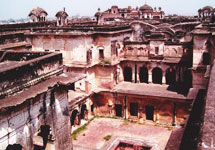 After Breakfast visit Qila Mubarak Though historians have tried to trace the origin of Patiala (as far as the name is concerned) to Rig Vedic literature yet the town as it stands today was founded by Ala Singh with the construction of the Qila Mubarak in the year 1763. One gets the impression as if the city was designed and developed according to a plan akin to that of temple architecture. In the heart of the city was the seat of the king similar to the house of the deity and the residential areas of communities developed almost status-wise. Close to Qila Mubarak were the Mohallas of the Khatris, Aroras, Baniyas along with the big Havelis of the nobility, the first settlers of Patiala were the Hindus of Sirhind, who opened their business establishments outside the Darshani Gate. The lower caste got settled on the peripheral areas of the Patiala city now known as ChurMajris. As in all the medieval towns, there were separate localities of dancing girls. Dharampura Bazar was one such in Patiala, which was frequented by the ruling elite. In the late nineteenth century, the ruling class having been granted huge Jagirs became rich and started constructing huge mansions with sprawling lawns. Some of the buildings though shabbily maintained, stand as mute evidence of that feudal glory. Maharaja Narendra Singh (1845-1862) fortified the city of Patiala by constructing ramparts and ten gates around the city. Some of these gates have been demolished to facilitate the flow of traffic. Inside the walls, besides the residences, there are Mandis and Bazars and a visitor with meagre amount in his pocket can still indulge in the luxury of purchasing traditional goods famous for their art and beauty such as embroidered Juti and Phulkari.
After Breakfast visit Qila Mubarak Though historians have tried to trace the origin of Patiala (as far as the name is concerned) to Rig Vedic literature yet the town as it stands today was founded by Ala Singh with the construction of the Qila Mubarak in the year 1763. One gets the impression as if the city was designed and developed according to a plan akin to that of temple architecture. In the heart of the city was the seat of the king similar to the house of the deity and the residential areas of communities developed almost status-wise. Close to Qila Mubarak were the Mohallas of the Khatris, Aroras, Baniyas along with the big Havelis of the nobility, the first settlers of Patiala were the Hindus of Sirhind, who opened their business establishments outside the Darshani Gate. The lower caste got settled on the peripheral areas of the Patiala city now known as ChurMajris. As in all the medieval towns, there were separate localities of dancing girls. Dharampura Bazar was one such in Patiala, which was frequented by the ruling elite. In the late nineteenth century, the ruling class having been granted huge Jagirs became rich and started constructing huge mansions with sprawling lawns. Some of the buildings though shabbily maintained, stand as mute evidence of that feudal glory. Maharaja Narendra Singh (1845-1862) fortified the city of Patiala by constructing ramparts and ten gates around the city. Some of these gates have been demolished to facilitate the flow of traffic. Inside the walls, besides the residences, there are Mandis and Bazars and a visitor with meagre amount in his pocket can still indulge in the luxury of purchasing traditional goods famous for their art and beauty such as embroidered Juti and Phulkari.
Later day free for shopping in Patiala. Overnight Stay in hotel.
Day 09 : Anandpur sahib
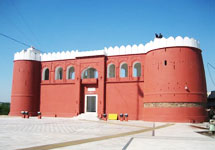 After Breakfast drive to Anandpur Sahib to visit 5 forts constructed by Guru Gobind Singh at Anandpur sahib, Fort Keshgarh- Keshgarh is the name given to the main fort that the tenth Master constructed in Anandpur sahib in 1699. The fort is now the Takhat called Keshgarh Sahib. This Gurdwara was one of the five (sometimes quoted as six) forts constructed by Guru Gobind Singh at Anandpur Sahib for the defence of the Sikhs and the community. All the forts were joined together with earthworks and underground tunnels. Sometimes this shrine is not regarded as a fort and the construction is different from the other "proper" five forts.The construction began in 1689 and took over ten years to complete. Guru Gobind Singh used to hold congregations on this hill. His revelation of the Khalsa and its first initiation (Khande Di Pahul) took place here in 1699. At that time the hill of Keshgarh Sahib was at least 10-15 feat higher than it is today. It was a very strong fort and before reaching the gates of this fort the armies had to capture the fort at Taragarh, Agamgarh, Fatehgarh and Anandgarh. This fort was never taken in the history of Anandpur Sahib, until Guru Gobind Singh ji's decision to leave the city.
After Breakfast drive to Anandpur Sahib to visit 5 forts constructed by Guru Gobind Singh at Anandpur sahib, Fort Keshgarh- Keshgarh is the name given to the main fort that the tenth Master constructed in Anandpur sahib in 1699. The fort is now the Takhat called Keshgarh Sahib. This Gurdwara was one of the five (sometimes quoted as six) forts constructed by Guru Gobind Singh at Anandpur Sahib for the defence of the Sikhs and the community. All the forts were joined together with earthworks and underground tunnels. Sometimes this shrine is not regarded as a fort and the construction is different from the other "proper" five forts.The construction began in 1689 and took over ten years to complete. Guru Gobind Singh used to hold congregations on this hill. His revelation of the Khalsa and its first initiation (Khande Di Pahul) took place here in 1699. At that time the hill of Keshgarh Sahib was at least 10-15 feat higher than it is today. It was a very strong fort and before reaching the gates of this fort the armies had to capture the fort at Taragarh, Agamgarh, Fatehgarh and Anandgarh. This fort was never taken in the history of Anandpur Sahib, until Guru Gobind Singh ji's decision to leave the city.
Qila Lohgarh (fort of steel) - Lohgarh was the second strongest Qila after Qila Anandgarh sahib as it was on southern side of city Guru Sahib had set up a factory for manufacturing of arms. The hill armies attacked city Anandpur sahib many times but hesitated to attack the Qila because of their fear that its gate could not be broken.It is situated at one and a half kilometre southwest of Takht Sri Kesgarh Sahib, marks the site of the fort of that name constructed by Guru Gobind Singh to protect the riverside flank of Anandpur. It was here that BhaiBachchittar Singh faced and turned back a drunken elephant which the hill chiefs, during their siege of Anandpur in 1700, had sent to batter down the gate of this fort. It was in this fort that the arms and ammunition were manufactured.
Agamgarh or Holgarh (fort of colour) - Agamgarh or Holgarh was the qila where Guru Gobind Singh introduced in the spring of 1701, the celebration of HolaMahala on the day following the Hindu festival of colour, Holi. Unlike the playful sprinkling of coloured powders or spraying of colored water during Holi, the Guru made HolaMahalu an occasion for Sikhs to demonstrate their skills at arms in simulated battles. The fort is about one and a half km north-west of the town across the CharanGariga rivulet. It was the third strongest fort built by Guru Gobind Singh ji.
Qila Anandgarh(fort of bliss) - Anandgarh is one from five Kilas Built By Shri Guru Gobind Singh Ji for the protection of sikhs from Hill rulers. In Gurudwara Sahib also there is Sacred Baoli Sahib. It is situated in the middle of ShriAnandpur Sahib on another spur, about 800 metres southeast of Takht Sri Kesgarh Sahib.
QilaFatehgarh sahib (fort of victory) - Fatehgarh was built By Shri Guru Gobind Singh to defend the Anandpur Sahib city in the territory of sahota village. When this Qila was built SahibzadaFateh Singh Ji was born, hence it was named in his honor as QilaFatehgarh Sahib. It is situated on the northern outskirts of the town of Anandpur, marks the site of another fortress bearing this name. This Fort reminds long long struggle between the mughals and great defender of 'Anandpuri'.Later drive back to Chandigarh overnight stay.
Day 10 : Chandigarh
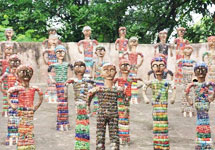 After Breakfast drive to Chandigarh on arrival at Chandigarh check inn hotel. Then full day for leisure& Shopping. Overnight stay in hotel.
After Breakfast drive to Chandigarh on arrival at Chandigarh check inn hotel. Then full day for leisure& Shopping. Overnight stay in hotel.
Day 11 : Departure
After breakfast drive to Chandigarh. Transfer you to Railway Station/Airport for your onward journey.
Tour Packages
- North India Agriculture Tour9 Nights / 10 Days
- Amritsar 1 Day Sightseeing TourAC Car, Mineral Water, Veg. Lunch (Punjabi Thali)
- Amritsar Village Day TripTractor Ride, Veg.Lunch, Farming, Interact Villager.
- Delhi to Amritsar Darshan with Village Trip3 Days
- Amritsar City with Village Tour1 Nights / 2 Days
- Amritsar Day Trip with Village Tour
- Amritsar Day Trip with Sada Pind Cultural Show
- Amritsar, Punjab, Kurukshetra, Chandigarh
- Delhi, Punjab, Delhi 7 Days
- Delhi Amritsar Delhi 1 Nights / 2 Days
- Hola Mohalla Festival3 Nights / 4 Days
- Punjab Educational Tour Package4 Nights / 5 Days
- Punjab Culture and Heritage Tour4 Nights / 5 Days
- Punjab Architecture Tour Package7 Nights / 8 Days
- Punjab Nature and Eco Tour Package4 Nights / 5 Days
- Punjab Tour Package6 Nights / 7 Days
- Punjab Forts and Monuments Tour10 Nights / 11 Days
- Punjab Volunteers Tour Package4 Nights / 5 Days
- 5 Sarovar Darshan Tour Package1 Night / 2 Days
- Punjab Tour Package5 Nights / 6 Days
- Heritage Walk in Amritsar Tour Package2 Nights / 3 Days
- Punjab Gurudwara Darshan Tour7 Nights / 8 Days
- Golden Temple with Buddhist Tour4 Nights / 5 Days
- Honeymoon Paradise Punjab Tour4 Nights / 5 Days
- Amritsar with Kartarpur Sahib Tour2 Nights / 3 Days
- Kila Raipur Sports Festival Package5 Nights / 6 Days
- Punjab Cooking with Homestay Package1 N / 2 D
- Delhi with Punjab Tour Package7 N / 8 D
- Chandigarh Amritsar Tour Package4 N / 5 D
- Amritsar Dalhousie Shimla Chandigarh Tour Package 6 Nights / 7 Days
- Amritsar Village with Jalandhar Tour Package 2 Nights / 3 Day
- Punjab with Himachal Tour Package 15 Nights / 16 Days
- Amritsar, Anandpur, Manikaran Sahib Gurudwara Tour 5 Nights / 6 Days
Short Tour Packages
- Amritsar Short Tour1 Day Sightseeing
- Chandigarh Short Tour1 Day Sightseeing
- Ludhiana Short Tour1 Day Sightseeing
- Jalandhar Short Tour1 Day Sightseeing
- Kapurthala Short Tour1 Day Sightseeing
- Patiala Short Tour1 Day Sightseeing
- Bathinda Short Tour1 Day Sightseeing
- Gurdaspur Short Tour1 Day Sightseeing
- Faridkot Short Tour1 Day Sightseeing
- Ferozepur Short Tour1 Day Sightseeing
- Muktsar Short Tour1 Day Sightseeing
- Rupnagar Short Tour1 Day Sightseeing
- Sangrur Short Tour1 Day Sightseeing
- Moga Short Tour1 Day Sightseeing
Main Links
Travel Information
Exploring Punjab - Vacations
Punjab's Forestry and Wildlife
The Unique eco-system of the Shivaliks is spread over a geographical area 9448.97 Sq. km, and lies in the north-eatern part of the state extending from north-west to south-east along the Himachal Pradesh Border. It is spread across the eastern part of the districts of Gurdaspur, Hoshiarpur, Shaheed Bhagat Singh Nagar and Rupnagar


